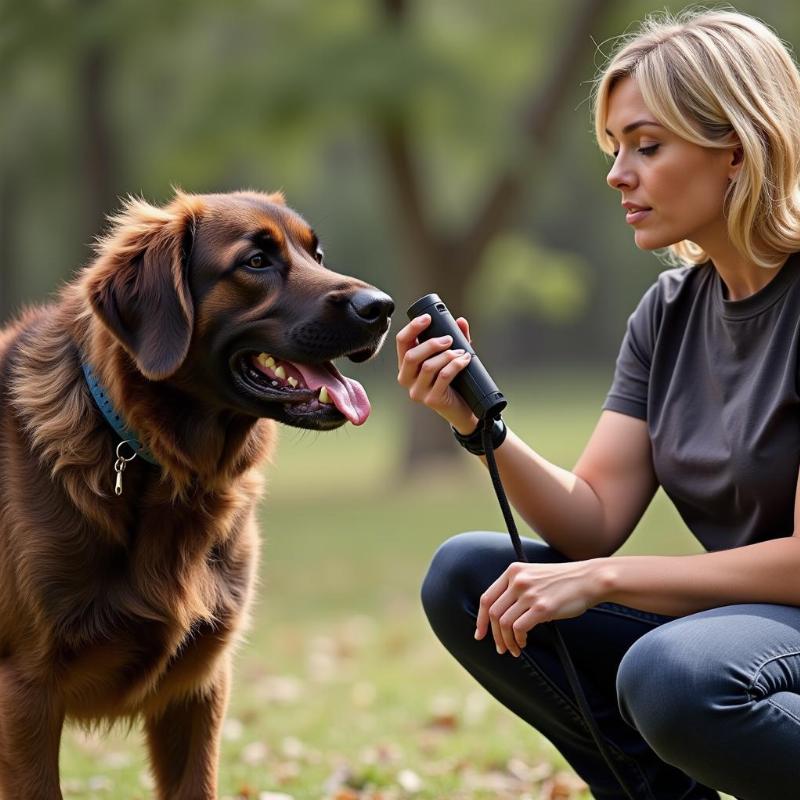Finding the right shock collar for a large dog with thick fur can be a challenge. You want something effective, safe, and comfortable for your furry friend. This article dives into the key factors to consider when choosing a shock collar, including fur thickness, dog size, temperament, and training goals. We’ll also discuss important safety considerations and highlight some top-rated options available in the US market. Let’s find the perfect fit for your large, fluffy companion!
Navigating the World of Shock Collars for Large, Thick-Coated Dogs
Choosing a shock collar for a large dog, especially one with thick fur, requires careful consideration. The effectiveness of a shock collar can be impacted by the density of the fur, and you need to ensure the contact points can reach the skin. For dogs with particularly dense coats, you might need to consider collars with longer prongs or alternative training methods. Beyond fur thickness, factors like your dog’s size, temperament, and your training goals are crucial in selecting the right collar.
Key Considerations for Choosing a Shock Collar
When selecting a shock collar, prioritize safety and effectiveness. Look for collars with adjustable stimulation levels, allowing you to find the lowest effective setting for your dog. A good collar will offer multiple training modes, like vibration and tone, in addition to static stimulation. These features allow you to tailor the training approach to your dog’s individual needs. For large dogs, a collar with a long range can be beneficial, especially for off-leash training in larger areas.
Top-Rated Shock Collars for Large Dogs with Thick Fur
Several brands offer shock collars specifically designed for larger breeds with thick coats. Some popular choices in the US market include Educator, Garmin, and Dogtra. These brands offer collars with varying features, range, and stimulation levels. Researching reviews and comparing features is essential to finding the right fit for your dog.
Safety and Training Tips for Using Shock Collars
Shock collars should never be used as a punishment tool. Instead, they should be integrated into a positive reinforcement training program. Start with the lowest stimulation level and gradually increase it only if necessary. Always prioritize your dog’s comfort and well-being. Consult with a certified dog trainer for personalized guidance and ensure you’re using the collar effectively and humanely.
Understanding Your Dog’s Temperament and Training Goals
Is your dog easily startled or more stubborn? Understanding their temperament is vital in choosing the right training approach and shock collar settings. Define your training goals. Are you focusing on basic obedience, curbing unwanted behaviors, or off-leash training? Your goals will influence the type of collar and features you need.
 Dog Training with Shock Collar
Dog Training with Shock Collar
Conclusion: Finding the Perfect Shock Collar for Your Large, Fluffy Friend
Selecting the best shock collar for your large dog with thick fur requires careful research and consideration of your dog’s individual needs. By focusing on safety, effectiveness, and proper training techniques, you can ensure a positive and successful training experience for both you and your furry companion. Remember to prioritize your dog’s well-being and always consult with a professional if you have questions or concerns.
FAQ:
- How do I choose the right prong length for my dog’s thick fur? Consult the manufacturer’s recommendations and consider your dog’s individual fur density. Longer prongs may be necessary for very thick coats.
- Are shock collars safe for my dog? When used correctly and as part of a positive reinforcement training program, shock collars can be a safe and effective training tool.
- What are the different training modes available on shock collars? Many collars offer vibration, tone, and static stimulation modes, allowing for varied training approaches.
- How do I introduce a shock collar to my dog? Start slowly and pair the collar with positive reinforcement. Begin with the lowest stimulation level and gradually increase as needed.
- Can I use a shock collar on a puppy? Consult with a veterinarian or professional trainer before using a shock collar on a puppy.
- How do I find a certified dog trainer in my area? The Certification Council for Professional Dog Trainers (CCPDT) is a great resource for finding certified trainers in the US.
- What should I do if my dog reacts negatively to the shock collar? Immediately discontinue use and consult with a veterinarian or professional trainer.
Beautdogs.us is your premier online destination for all things dog-related in the US. We offer expert advice on dog breeds, grooming, training, and health, providing a reliable resource for both new and experienced dog owners. Explore our wide selection of products and services tailored to the needs of dog lovers across America. Contact us today for personalized guidance and support! Email: [email protected], Phone: +1 501-555-7529. Visit Beautdogs.us for expert advice and resources.